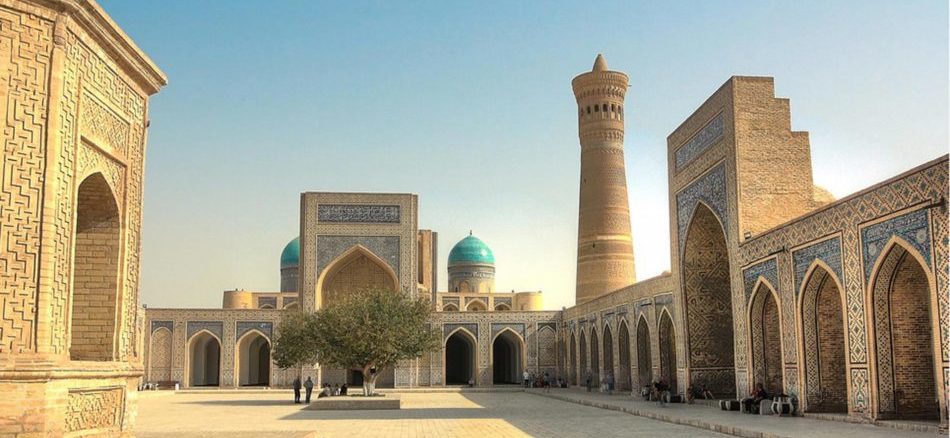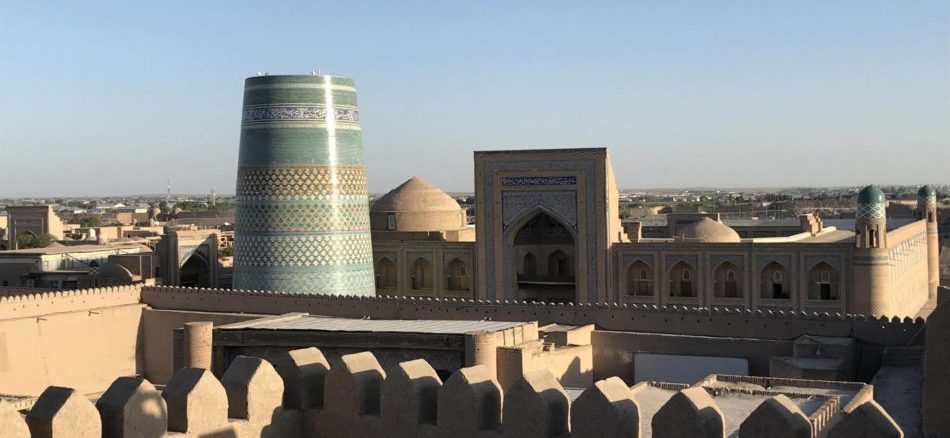TOUR 9 DAYS TO UZBEKISTAN
Tour 9 days to Uzbekistan: Tashkent-Urgench-Khiva-Bukhara-Shakhrisabz-Samarkand-Tashkent

Itinerary of tour 9 days Uzbekistan: Tashkent-Urgench-Khiva-Bukhara-Shakhrisabz-Samarkand-Tashkent
Accomodations of 9 days tour Uzbekistan
- 2 nights in Tashkent – Tashkent Palace 4****
- 2 nights in Khiva – Asia Khiva 3***
- 2 nights in Bukhara – Asia Bukhara 4****
- 2 nights in Samarkand – Hotel Diyora 4****

Detailed program of trip
1 DAY HOME – TASHKENT (flight + 10 km)
Departure from home with TURKISH AIRLINES via Istanbul or AEROFLOT via Moscow and overnight on board. Early morning arrival in Tashkent. Meet guide of your group, transfer to hotel (10 km) and overnight.
2 DAY TASHKENT – URGENCH – KHIVA (excursion + flight + 35 km)
Breakfast. Transfer to the north-east part of Tashkent, that’s ancient part called as ‘old city’. Excursion in the city visiting: ‘Khasti-Imom’ complex: madrassa, mosque, mausoleum & museum of the Holy Koran. Mausoleum of Kaffol Shoshiy (903-976), Madrassa of Barakkhan (XVI cen.), was one of the most popular Koranik school, today is center of craftmen. Museum of Moyi Mubarek is very interesting sacred place, where Holy Koran – Osman’s Koran (VII cen.). Mosque Tilla Sheikh (1890 y.) is functioning mosque, where Muslims pray five times a day. Transfer to Bazar Chorsu, visit market of local people, it exists since ancient times and considered as the most beautiful market in Tashkent and is full of people every day. Transfer to Museum of Applied Arts, which was built (the end of the XIX century) by Russian ambassador Plovsev, who used it as his residence. It exists as museum since 1937. Transfer to airport & departure for Urgench with local flight HY-1057 (18:40 – 20:20). Arrival in Urgench & transfer to Khiva (35 km). Dinner and overnight in the hotel.
3 DAY KHIVA (excursion)
After breakfast in the hotel we start full day city tour of Khiva – one of the most fascinating cities in the region. Madrassa Mukhammad Amin Khan (XIX century) was the biggest madrassah, there were 125 rooms for 250 students. Minaret – Kalta Minor (XIX cen.) is very interesting historical monument, it had to be highest, but the owner of minaret died when it was 28 meters. Konya Ark was the residence of governors between XVII and XIX century. Madrassah Mukhammad Rakhim Khan II was built in 1871, was closed in the beginning of the XX century. The Mausoleum of Pakhlavan Makhmud (XIX cen.), is the most sacred mausoleum of Khiva. He was poet and sufi (1247-1325), on his tomb the mausoleum with dome (XIV century) was built, but later destroyed. In 1913 there was built a new complex.
Madrassah, Minaret & First Russian School were built by Islam Khodja (was Prime Minister) in 1910, when he was Prime Minister of Khiva. From that time till today Islam Khodja’s Minaret is the highest minaret of Uzbekistan (57 meters). The large Friday Mosque is famous for its 218 wooden columns supporting its roof – a concept thought to be derived from ancient Arabian mosques. Our visit in Khiva ends with complex of ‘Tash Hovli’ (Stone Home). Palace Tash Hovli served as the summer residence of Khan Allakuli and it was completely built by the end of the XIX century. Dinner at local restaurant & overnight in the hotel.
4 DAY KHIVA – BUKHARA (480 km)
Breakfast. Transfer to Bukhara (480 km). Our route goes crossing the Amu-Darya River and the Red Desert (Kyzilkum). In Uzbekistan there are two great rivers: the Amu-Darya (in classical Greek known as the Oxus) and the Syr-Darya (known as Jaxartes or Yaxartes by the Greeks). Amu Darya flows through Turkmenistan from south to north, passing Turkmenabad and marking the border between Turkmenistan and Uzbekistan from Khalkabad. The Kyzylkum Desert, it is the 16th largest desert in the world. Its name means Red Sand in Turkish languages. It is located in Central Asia, in the territory between two rivers. Today it is divided between Kazakhstan, Uzbekistan and (partly) Turkmenistan. It covers about 298,000 km2. Bukhara – is the city, which is important for country’s economy with its mineral deposits, particularly gold, uranium, aluminum, copper, silver, oil and natural gas. Arrival in Bukhara and hotel accommodation. Free time. Dinner at local restaurant & overnight in the hotel.
5 DAY BUKHARA (excursion)
Breakfast. The mausoleum of Samanids is located in the historical urban nucleus of the city of Bukhara, in a park laid out on the site of an ancient cemetery. This mausoleum, which is one of the most esteemed sights of Central Asian architecture, was built in the IX (X) century (between 892 and 943). Mausoleum of Chashma-i Ayub is located near the Samani Mausoleum. Its name means Job’s well, due to the legend in which Job (Ayub) visited this place and made a well by striking the ground with his staff. The water of this well is still pure and is considered healing. The Mosque of Bolo Khauz is situated opposite to The Ark, where the emirs worshiped. It was built in 1718 with a roof extension supported by karagachi (a rare sycamore-like wood) pillars in the XIX century. The Ark of Bukhara is a massive fortress located in the city of Bukhara, that was initially built and occupied around the V century AC. The Ark was used as a fortress until 1920. The square of Poi Kalyan (means “The Foot of the Great”), is an Islamic religious complex located around the Grand Minaret. The Grand Mosque (Masjid-i Kalon) was completed in 1514. It is equal in size to the Bibi-Khanym Mosque in Samarkand. Bazars: Taqi Sarrafon, Taqi-Telpak Furushon and Taqi-Zaragon. Ulugbek’s Madrassa is one of Central Asia’s architectural highlights, built by Ulugbek in 1417, sober and strictly proportioned. The Mosque of Magoki Attori was constructed on the remains of an older Zoroastrian temple.
The Lab-i Hauz Ensemble (meaning by the pond 1568–1622) is the name of the area surrounding one of the few remaining hauz (ponds) in the city of Bukhara. Until the Soviet period there were many such ponds, which were the city’s principal source of water, but they were notorious for spreading disease and were mostly filled in during the 1920s and 1930s. Dinner at local restaurant & overnight in the hotel.
6 DAY BUKHARA – SHAKHRISABZ – SAMARCANDA (270 km + excursion + 140 km)
Breakfast, transfer to Shakhrisabz (270 km). It means city of green or verdant city. It is a city in southern Uzbekistan located in the southern part of Samarkand. It was a major city of Central Asia, it is primarily known today as the birthplace of 14th-century Turk-Mongol conqueror Timur. Shahrisabz was the birthplace of Timur on April 9, 1336, who was born in the family of a minor local chief, and during the early years of the Timurids’ Dinasty, enjoyed its considerable patronage. Timur regarded Shahrisabz as his “home town” and planned it eventually to be the location of his tomb. Excursion in The Palace Ak-Saray, which was Timur’s Summer Palace (“White Palace”). It was planned as the most grandiose of all Timur’s constructions. It was started in 1380 by artisans deported by Timur from the recently conquered Khwarezm. Unfortunately, only traces of its gigantic 65 m gate-towers are survived with blue, white and gold mosaics. The Mosque of Kok Gumbaz / Dorut Tilovat Complex. The Friday Mosque was built in 1437 by Ulugbek in honor of his father Shahrukh, its name means “Blue Dome”. Located immediately behind the Mosque is the so-called “House of Meditation”, a mausoleum built by Ulugbek in 1438, but apparently never used for burials. Hazrat-i Imam Complex. On the Eastern part of the Mosque located another complex called Dorus-Saodat (Seat of Power and Might), which contains the Tomb of Jehangir, Timur’s eldest and favorite son. The adjacent mosque is said to house the tomb of a revered VIII century imam Amir Kulal.Behind the Hazrat-i Imam Ensemble is situated tomb of Timur. It is a bunker with a door leading to an underground chamber, discovered by archaeologists in 1943. The room is nearly filled with a single stone casket, on which inscriptions indicate that it was intended for Timur. However, the conqueror was buried in Samarkand, not in Shahrisabz. Transfer to Samarkand (140 km). Dinner at local restaurant & overnight in the hotel.
7 DAY SAMARKAND (excursion)
Breakfast.
The Mausoleum of Gur Amir is Persian for “Tomb of the King”. This architectural complex with its azure dome contains the tombs of Tamerlane, his sons Shakhrukh, Miranshakh and grandsons Ulugbek, Sultan Muhammad. Also honored with a place in the tomb is Timur’s teacher Sayyid Baraka. The earliest part of the complex was built at the end of the XIV century by the orders of Sultan Muhammad. Now only the foundations of the madrassah and khanaka, the entrance portal and a part of one of four minarets remains. The Registan Square was the heart of the ancient city of Samarkand of the Timurid’s dinasty. The name Registan means “Sandy place” or “desert” in Persian. It is framed by three madrassas of distinctive Islamic architecture: the three madrassas of the Registan are: The Ulugbek Madrassah (1417–1420), The Tilla-Kori Madrassah (1646–1660) and The Sher-Dor Madrassah (1619–1636). The Mosque Bibi Khanum is one of the most important monuments of Samarkand. In the XV century it was one of the largest and most magnificent mosques in the Islamic world. By the mid XX century only a grandiose ruin of it still survived, but now major parts of the mosque have been restored. The Mausoleum of Shah-i-Zinda (means “The Living King”) is a necropolis in the north-eastern part of Samarkand. The Shah-i-Zinda Ensemble includes mausoleums and other ritual buildings of IX-XIV and XIX centuries. The Shah-i-Zinda is connected with the legend that Kusam ibn Abbas, the cousin of the prophet Muhammad was buried there. The Ulugbek’s Observatory was built in the XV century by the Timurid astronomer Ulugbek, it is considered by scholars as one of the finest observatories in the Islamic world in that century. Some of the famous Islamic astronomers who worked at the observatory include Al-Kashi, Ali Qushchi and Ulugbek himself. The observatory was destroyed in 1449 and rediscovered in 1908. Dinner at local restaurant & overnight in the hotel.
8 DAY SAMARKAND – TASHKENT (excursion + 280 km)
Breakfast, free time till 12.00. ‘Check out’ from the hotel. Excursion in Museum Afrosiyob. It was an ancient site of northern Samarkand, that was occupied from c 500 BC to 1220 AD. Today, it is a hilly grass mound located near the Bibi Khanaum Mosque. Afrasiyab is the oldest part and the ruined site of the ancient and medieval city of Samarkand. It was located on high ground for defensive reasons, south of a river valley and north of a large fertile area which has now became part of the city of Samarkand. The habitation of the territories of Afrasiyab began in the VII-VI centuries BC, as the centre of the Sogdian culture. The Tomb of Daniel is the traditional burial place of the biblical prophet Daniel. Various locations have been named for the site, but the tomb in Susa, Iran, is the most widely accepted, it being first mentioned by Benjamin of Tudela, who visited Asia between 1160 and 1163. Transfer to Tashkent. Dinner at local restaurant & overnight in the hotel.
9 DAY TASHKENT – HOME (10 km + flight)
Early morning, transfer from hotel to airport & departure to home.






